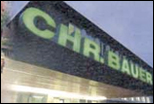| |
|
 |
 |
| |
|
 |
 At CHRISTIAN
BAUER you can find a wealth of experience about spring
elements under one roof.
At CHRISTIAN
BAUER you can find a wealth of experience about spring
elements under one roof. |
 |
|
|
| |
 |
 |
 |
| |
|
Disc Springs
(Online
Catalog)
- Precision
manufactured with outside diameters ranging from 4 - 1000mm (0.157"
- 39.37"), spring thickness from 0.1 - 60mm (0.004"
- 2.36"), plus all standard and custom inch sizes.
- Available
with linear, convex, concave or negative characteristics
- Used in
dynamic, impacting or static load applications - depending on
customer requirements.
- Capable
of many millions of cycles - depending on type of use.
- Complete
predictability of force.
- Occupy less
space for equivalent forces compared to other spring designs.
- Excellent
permanent spring performance from low to elevated temperatures
(from -400°F to +1500°F) by selecting appropriate spring
materials (steel or others).
- Adaptable
to stacking in numerous configurations (stacks).
- Manufactured
to the very rigid DIN 2092 and 2093 disc spring specifications
(equivalent ASME, SAE or ASTM specification not available).
Why
use Disc Springs?
- The spring
characteristic (linear, positive or negative) can be engineered
to a large extent by means of changing the disc spring properties
(dimensions, adding slots on inside or outside, stacking, etc.)
- Very slight
spring deflections can be achieved by use of single springs.
- Using disc
springs in series, spring deflection increases, without materially
affecting the forces involved.
- They can
be combined into groups of serial and parallel order in the same
stack for special applications.
- Disc springs
show a symmetrical buildup of forces around the rotating axis,
with this symmetry being maintained throughout the lines of the
spring equally.
- They show
a circular, symmetrical transmission of forces in the exact direction
of the spring axis - this being directly in contrast to actions
of coil springs.
- They permit
the use of the smallest possible
working area - this being notably in contrast to the space required
to accommodate the "dead windings" of a coil spring.
- Disc springs
are characterized by high forces resulting from moderate spring
deflections - in direct contrast to other spring types.
Applications.
Here
are a few examples of applications with disc springs in use:
- Control Valve
- Safety Valve
- Automatic
Quick Tool Changer (CNC Machines, etc.)
- Torque Converter
- Clutches
Manual Transmission
- Nozzle of
Spray Injection Molding Unit
- Brake System
- Brake Slack
Adjuster
- Stamping
Machine
- Damper
- Over Load
Protection
- Etc.
|
|
|
|



